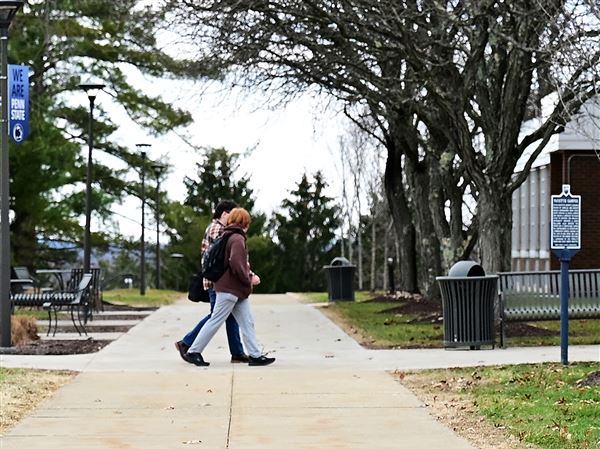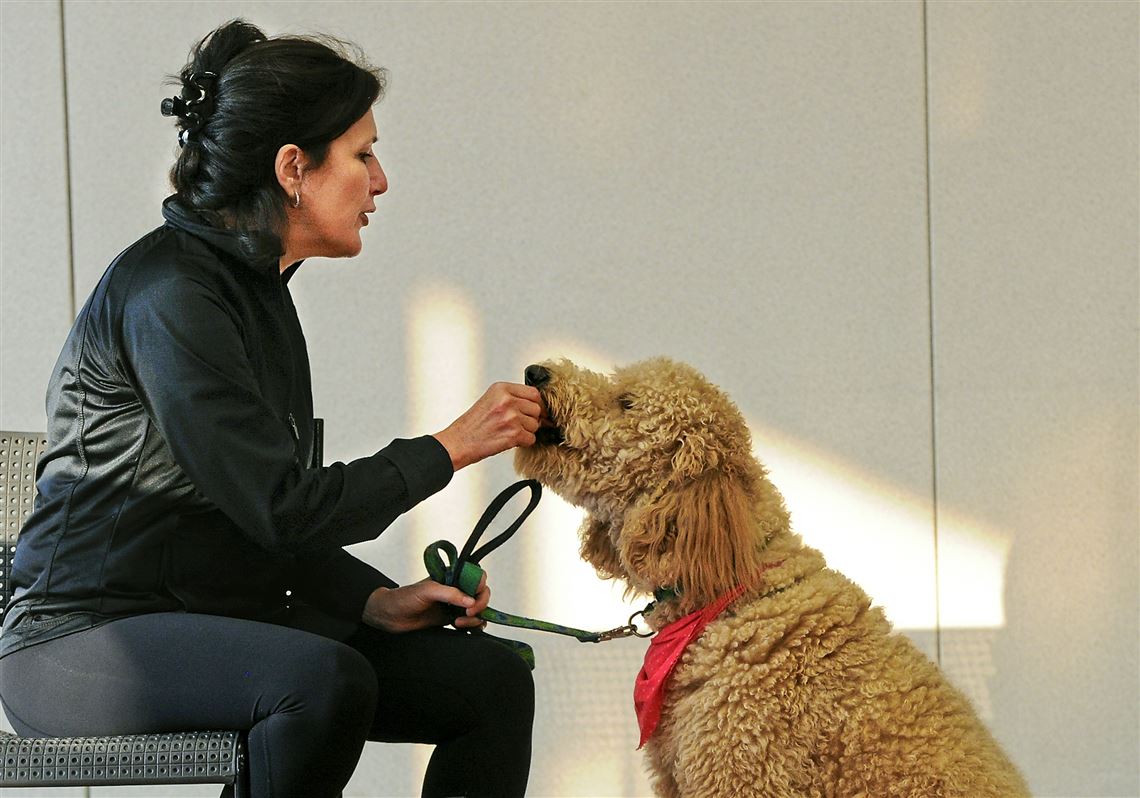“My dog loves all people and other dogs and would make a great therapy dog.”
That’s the reaction of many dog owners when they see beautifully behaved therapy dogs visiting people at hospitals, nursing homes, schools and elsewhere.
Yes, friendly dogs might be able to become therapy dogs, but they’ll need many hours of training, preferably in classes with other dogs, other people and an experienced trainer.
Obviously, dogs that are aggressive toward people or other dogs are not good candidates, but dogs that are fearful or uncomfortable around strangers generally don’t make good therapy dogs, either.
Many animal shelters, training clubs and private trainers can teach people how to work with their dogs to achieve the skills and behaviors needed to pass therapy dog certification tests.
But before dogs can enter the therapy dog training classes, most need to take classes in basic obedience. At the very least, they should be able to obey commands to sit, stand, lie down, come and stay. They should walk nicely on a leash and interact in a calm and friendly way with other dogs and with people.
The Western Pennsylvania Humane Society has a wide array of training classes, including classes that prepare dogs to pass the Therapy Dogs International certification test.
At a recent therapy dog training class at the North Side shelter, seven happy dogs with wagging tails circled the room, walking nicely on leashes.
The very large Newfoundland, Great Dane and Pyrenean mastiff peacefully co-existed with smaller dogs, including a pit bull and two mixed-breed dogs named Gus and Chance.
Instructor Marsha Robbins put the dogs through a number of exercises that mimic the certification test.
Therapy Dogs International, a nonprofit founded in 1976 in New Jersey, is the oldest therapy dog registry in the country. In 2012, the organization had nearly 25,000 dog-and-handler teams making volunteer visits.
All visits by therapy dogs are volunteer efforts. No one is paid.
Ms. Robbins threw a metal bowl on the floor. The loud noise attracted the attention of all the dogs, but none barked or acted scared, which would have resulted in a failing grade on the certification test.
Ms. Robbins poured dry dog food onto the floor and topped it with cheese. Some dogs eyed the food with apparent longing, but all walked by without trying to snatch a treat.
Then she moved on to one of the toughest parts of the Therapy Dogs International exam and other tests — an exercise in which the owner/handler leaves the room while the dog stays with the trainer and other owners.
Gus, 3, a small brown mixed-breed dog, sat quietly when owners Ken and Tatiana Kanashiro left the room. Another dog cried and howled like a baby, even though Ms. Robbins was at the dog’s side, providing comfort.
Trainers continue to work with dogs and handlers, repeating exercises until they get it right.
The recently married Kanashiro couple are justifiably proud of the dog they adopted from the Western Pennsylvania Humane Society. Gus is their first dog, and they have worked with him, fitting in training classes around their college course schedules — she’s at Carnegie Mellon University and he’s at Community College of Allegheny County.
Gus attended an earlier round of basic obedience classes. He and other dogs in the therapy dog training class, which started in August, will be tested Friday night.
Not just for purebreds
When therapy dogs were first being used, the dogs generally were well-bred, well-socialized, highly trained purebreds that had retired from the dog show circuit. The first Therapy Dogs International class consisted of five German shepherds and one collie. Now, many therapy dogs are mixed breeds and many come from shelters and rescue groups.
Ms. Robbins and some other trainers and programs teach classes that prepare dogs to take the Canine Good Citizen test. The Canine Good Citizen is a program of the American Kennel Club that encourages responsible dog ownership.
Some insurance companies require a Canine Good Citizen certificate to issue homeowners insurance, according to the American Kennel Club website, and some apartment and condominium managers require it for resident dogs.
Seven dogs were in a recent Canine Good Citizen class taught by Ms. Robbins, including Rooney, a Leonberger, which is a large, long-haired breed that originated in Germany.
Owners Nick and Jean Cardello of Mt. Lebanon have been bringing her to training classes since she was 7 months old. At 18 months, she passed the good citizen test.
“This is our third Leonberger,” Mrs. Cardello said, adding that Rooney is their third dog to pass the Canine Good Citizen test. They plan to continue Rooney’s training to obtain therapy dog certification. “We took our 150-pound male to hospital visits,” she said.
Most of the dogs in Rooney’s class were large to very large.
“People bring large dogs to training classes more than they bring small dogs,” said Ms. Robbins, who believes all dogs should attend training classes. All of the five dogs she owns are small, have been adopted from shelters and are certified training dogs.
Her dogs and other graduates regularly go to a number of places, including weekly visits at the University of Pittsburgh, where hundreds of students take study breaks with dogs at the Cathedral of Learning.
While some therapy dogs have earned titles in obedience, agility and other performance events from the American Kennel Club and other organizations, dogs that are “just a pet” also can be certified therapy dogs.
Sam is one of those dogs.
Adopted from a Fayette County shelter in 2008, owner Mary Beth Mueller of Forest Hills said Sam is sweet, patient, sociable and never aggressive. Still, he needed to take classes for four years before he qualified as a certified therapy dog.
At 6 years old, Sam, who is believed to be a Great Pyrenees/cocker spaniel mix, passed the Canine Good Citizen test and got his therapy dog certification from Animal Friends in Ohio Township.
“I like to do things with my dogs, and I do therapy instead of obedience or agility,” said Ms. Mueller, a self-employed public relations consultant.
She and Sam make regular visits at Blind & Vision Rehabilitation Services of Pittsburgh in Homestead.
Not just for dogs
The Animal Friends therapy program is called TheraPets. The staff has done its own testing and certification since September 2013. All animals in the program must be spayed or neutered.
Fifty dogs have been certified as well as seven rabbits and two cats, said Lauren Rimkus, therapeutic services coordinator at Animal Friends. “We’ve also gotten calls from people who want to use goats and pigs for therapy.”
Wanna-be therapy animals first get a free evaluation to determine whether they have the temperament and enough obedience training to take the therapy classes, which last six weeks and cost $90 plus $10 for the test. The shelter also offers a variety of basic obedience classes.
Cats and rabbits don’t take classes but get a free “pass/fail” evaluation. They just need to be calm and happy to be held and petted by strangers.
“The rabbits do especially well with Alzheimer’s patients,” Ms. Rimkus said. “Petting a rabbit’s especially soft fur seems to trigger memories with patients.”
The Westmoreland County Obedience Training Club in Delmont has a variety of training classes for members who compete in dog shows as well as for people who have pets.
The club’s therapy dog training and testing is under Therapy Dogs Inc., based in Cheyenne, Wyoming, which is a different organization from Therapy Dogs International.
Trainer and tester Hollee Russell of Jeannette and her Rottweiler, Josie, will be featured in a program about therapy dogs at 7:30 p.m. Nov. 6 on WQED-TV.
First Published: October 16, 2014, 4:00 a.m.



















